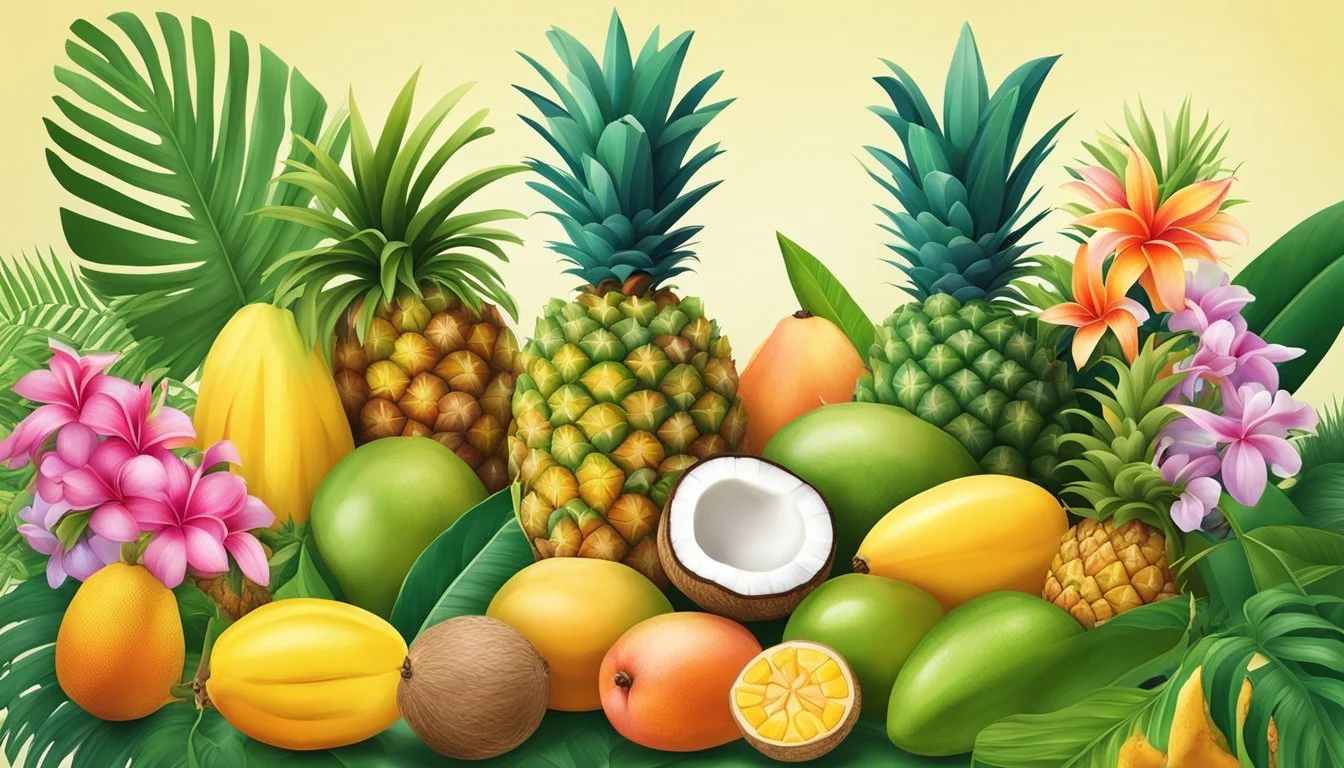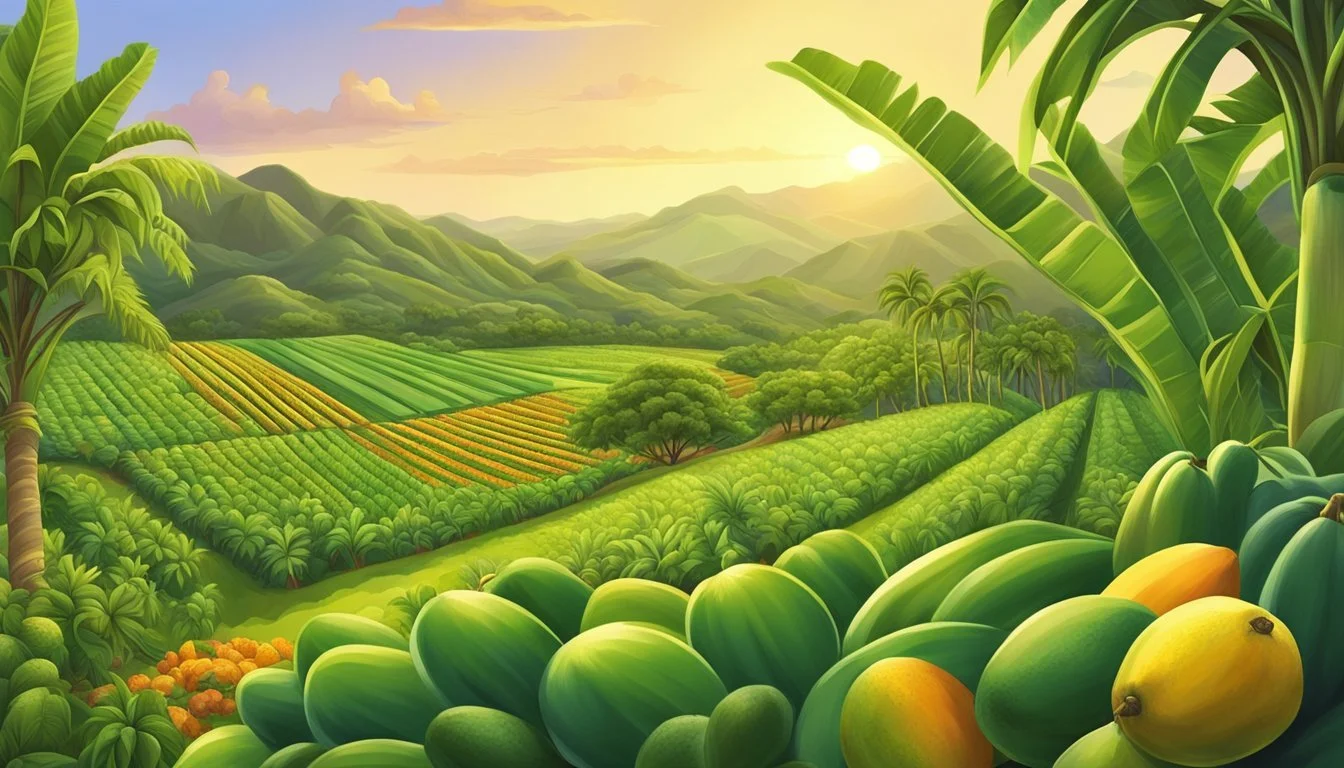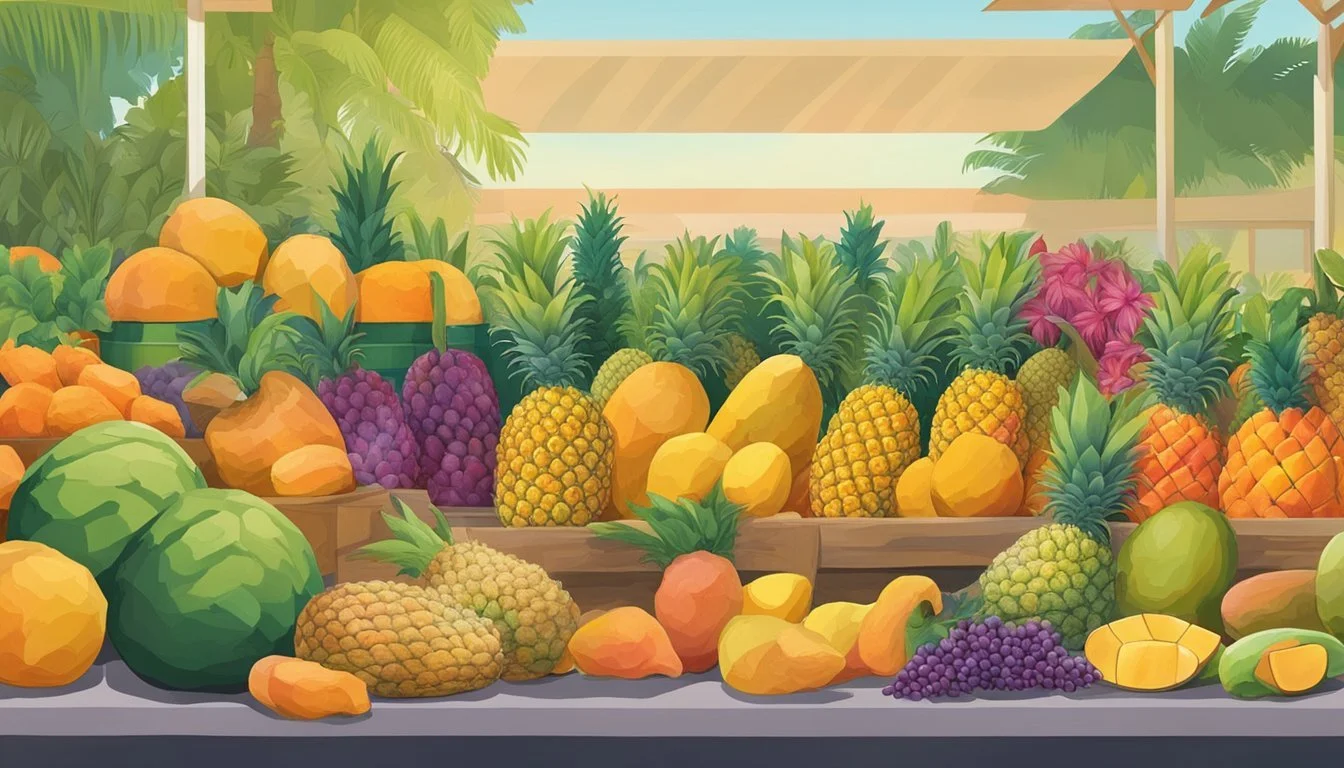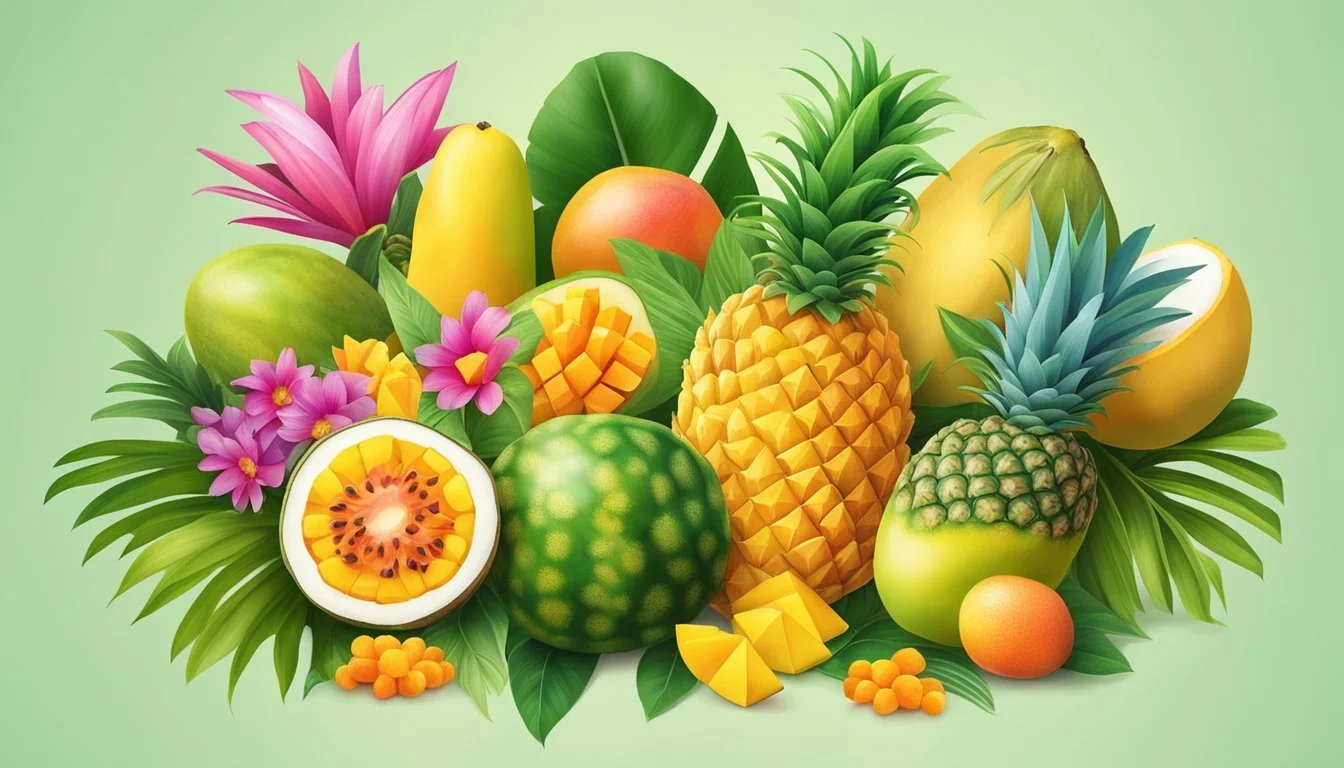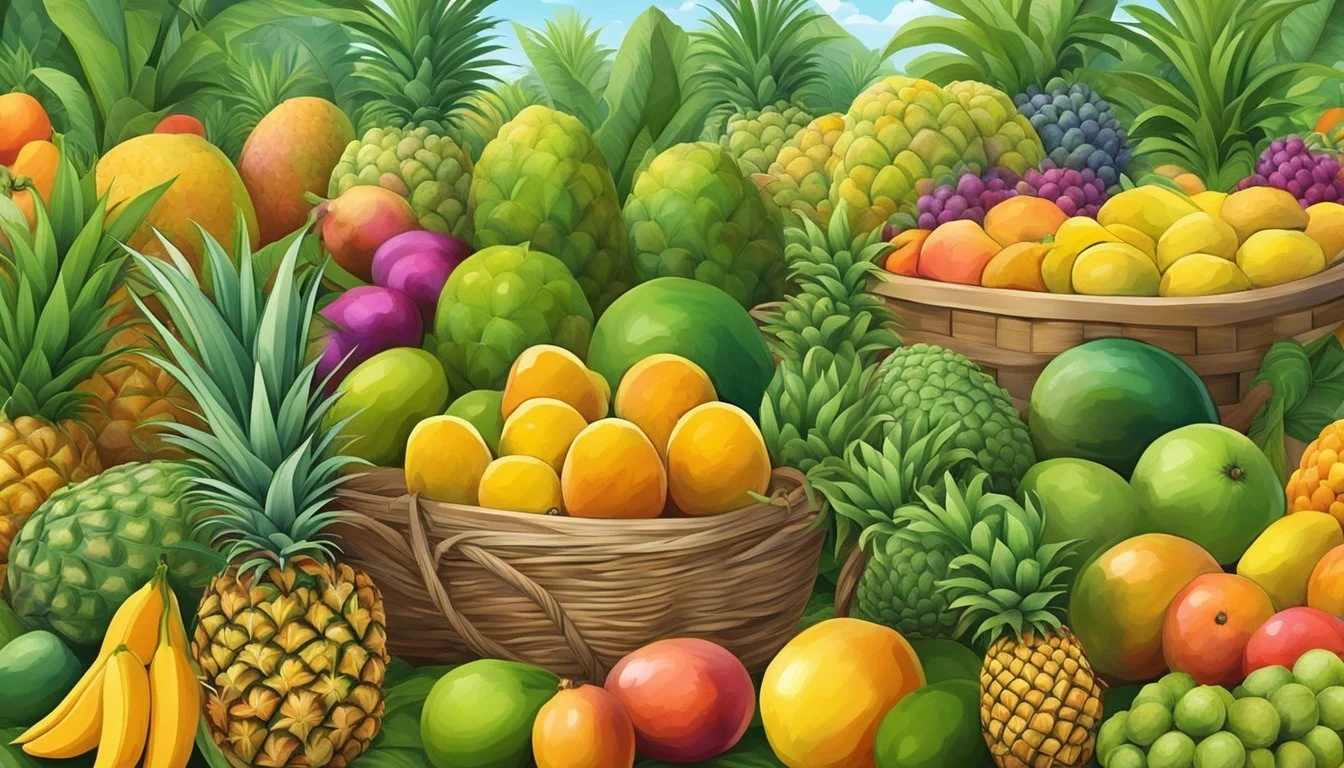Hawaii Seasonal Fruit & Vegetables in May
A Guide to the Best Picks
This Article is Part of our Hawaii Seasonal Fruit & Veg Calendar
May in Hawaii presents a diverse palette of flavors from the islands' unique produce. During this period of transition from spring to summer, the Hawaiian archipelago offers a blend of fruits (What wine goes well with fruits?) and vegetables that embody the region's agricultural richness. With a climate that ranges from tropical to temperate, Hawaii's fertile soils yield a bounty of fresh produce year-round.
Hawaiian fruits coming into season in May include the sweet and aromatic lychee, the tender and creamy mango, and the unique lilikoi, also known as passion fruit, with its tart and fragrant pulp. The islands' position in the Pacific and their volcanic soil contribute to the exceptional taste and quality of this produce, distinguishing it from counterparts grown elsewhere.
The seasonal harvest not only reflects the islands' diverse ecosystems but also their cultural heritage, as many fruits and vegetables are integral to Hawaiian cuisine and traditions. As such, the abundance of May's harvest plays a role in local dishes and celebrations, marking the month as a special time for both locals and visitors seeking to experience Hawaii through its flavors.
Overview of Seasonal Fruits
May in Hawaii offers a wealth of tropical fruit selections that are in season and at their peak of ripeness. Fruit enthusiasts can enjoy a range of succulent and aromatic options.
Mangoes are a standout in May, with their rich, sweet flavor. These fruits are a favorite for their fleshy, vibrant yellow-orange pulp. Lychee, with their distinct floral taste and jelly-like texture, typically start their season in May, providing a deliciously exotic treat.
Papayas are another common sight at local fruit stands. They are known for their buttery consistency and health benefits. Bananas, a staple in the Hawaiian diet, continue to be available throughout May, offering their universal appeal and versatility.
While guava and coconuts can be found, their abundance usually varies with changing local conditions. Strawberries may not be tropical, but they are cultivated in Hawaii and reach peak season in early May, adding a familiar sweet and slightly tart option for fruit lovers.
Hawaii's pineapple, one of the most iconic fruits, is available year-round due to the islands' ideal growing conditions; however, May often marks the beginning of peak season, ensuring the fruit is especially delicious.
Here is a brief list of some fruits that are generally available in May:
Mangoes: Sweet, Ripe, and Tropical
Lychee: Exotic with a distinct flavor profile
Papaya: Buttery texture, rich in nutrients
Bananas: Versatile, readily available
Pineapples: Iconic, flavorful, and juicy
Guava: Aromatic with a hint of sweetness
Coconuts: Refreshing with various culinary uses
Strawberries: Sweet-tart, locally grown
Consumers looking for fresh, locally-grown Hawaiian fruit will find May to be an excellent time to indulge in these natural delights.
Hawaii's Unique Growing Conditions
Hawaii presents a dynamic environment for growing a variety of produce. The islands' geographic isolation, combined with distinctive climate patterns, shape the conditions under which a range of crops thrive.
Climate and Soil
The Hawaiian Islands are characterized by a tropical climate that is conducive to the year-round cultivation of many fruits and vegetables. Temperatures rarely dip below 60°F (15°C) even in the cooler months, providing a warm growing period that is atypical for many regions of the world. Rainfall can be abundant, particularly on the windward sides of the islands, yet varies significantly across different areas, with some regions receiving over 300 inches of rain annually and others seeing less than 20 inches.
Soil conditions across Hawaii are equally diverse, arising from the archipelago’s volcanic origin. These volcanic soils range from rich, fertile earth to areas of more rugged, raw lava flows. This variability results in a patchwork of agricultural zones, each uniquely suited for different types of produce.
Ocean Influence
In Hawaii, the ocean has a profound impact on agricultural conditions. Its vastness tempers the climate, ensuring that temperatures remain relatively stable, rarely experiencing the temperature extremes found on continental landmasses. Trade winds, which are ocean-driven gusts, help to moderate the climate, alleviating the potential for overheating in crops and providing natural pest control.
The ocean also contributes to the nutrients found in the islands' soil. Salt spray and sea mists can carry minerals inland, which then settle into the soil, enhancing its fertility. Farmers must manage the effects of salinity but often find that the unique mineral composition contributes to the distinct flavor profiles of the local produce that is then sold at farmer’s markets and enjoyed by residents and visitors alike.
Typical Harvest Times
In Hawaii, the month of May is a transitional period featuring the tail end of the pineapple harvest and the exciting onset of the mango season. These fruits, among the islands' most popular, signify a time of bountiful picking and freshness.
Pineapples from April to May
During April and May, pineapples are nearing the end of their prime harvest season in Hawaii. This period is critical for pineapple picking, as the quality of the fruit is at its peak. The ideal conditions of the earlier months ensure that pineapples thrive, resulting in sweet and juicy produce that embodies the tropical essence of the region.
Mango Season Begins
With the arrival of May, the mango season begins, placing these succulent fruits at the forefront of the seasonal harvest. Mango trees start to burgeon with the promise of ripe fruit, a process that will continue through November. This month marks the start for mango lovers to relish the fresh flavors of locally grown varieties, each bringing its unique taste and texture to the island's fruit landscape.
Farmers' Markets and Eating Locally
Farmers' markets on the Hawaiian islands including Maui and the Big Island provide a unique opportunity for visitors and residents to eat locally and seasonally. These markets are bustling hubs where a variety of fresh, local fruit and vegetables are readily available. When exploring markets, one is likely to encounter an array of produce that reflects the season's offerings.
In May, shoppers can find tropical delights such as mangoes, lychees, and papayas. Local fruit like these are not just fresh but picked at the peak of ripeness, ensuring maximum flavor.
Notable Farmers' Markets:
Maui
Upcountry Farmers Market: Known for its wide range of local produce with a friendly atmosphere, it’s a must-visit for food enthusiasts seeking genuine Hawaiian flavors.
Big Island
Kamuela Farmers Market: This market, nestled on the historic Pukalani Stables, showcases the vibrant agricultural community of Hawaii.
Here is what visitors may find when they venture to these local markets:
Fruits: Mangoes, lychees, papayas
Vegetables: Kale, sweet potatoes (What wine goes well with sweet potatoes?), tomatoes
Eating locally in Hawaii supports the farming community and reduces the environmental impact associated with long-distance food transport. Farmers gain a fairer share of the profit and consumers enjoy fresher, more nutritious produce. The Farm, as a collective notion, is not just a source of sustenance but a cornerstone of community and sustainability in the Hawaiian Islands.
Popular Fruits and Their Uses
In May, Hawaii's agriculture offers a variety of fruits that are ideal for a range of culinary applications. This section highlights several popular fruits and how they are commonly integrated into dishes and beverages.
Papaya in Salads and Smoothies
Papaya is a versatile fruit that one can enjoy fresh or as a part of various recipes. Papaya salads are refreshing, often featuring a mix of other fruits and vegetables, seasoned with lime or lemon juice. Moreover, papaya is a staple in smoothies due to its soft, creamy texture and its ability to blend well with other tropical flavors.
Lychee for Desserts and Jams
The sweet and fragrant lychee is frequently used in desserts, such as tarts and sorbets, lending a distinctive flavor. Lychee also makes for a delightful jam, which goes well with bread or as a filling in various pastries. The fruit's unique taste is a favorite in Hawaii and is harvested at peak ripeness for the best flavor in culinary preparations.
Pineapple in Baked Goods and Breakfast
Pineapple is synonymous with Hawaiian produce and shines in breakfast dishes, including pancakes and yogurt parfaits. The fruit's natural sweetness and fruit-acid balance make it perfect for incorporation into baked goods such as pies and cakes. It adds a tropical twist to any recipe, and fresh pineapple, in particular, can enhance the overall flavor of a dish.
Mango Varieties and Dishes
Hawaii is home to several mango varieties, each offering a unique flavor and texture profile suited for different dishes. Ripe mangoes are enjoyed fresh or utilized in savory salads, where they add sweetness and color. They are also pureed to create sauces or used in desserts like mango sticky rice and refreshing fruit sorbets.
Culinary Inspirations and Recipes
In Hawaii, May's bountiful harvest inspires a myriad of delectable dishes, from traditional luaus to modern fusion creations, each celebrating the island's freshest produce with innovative flavors and culinary techniques.
Traditional Hawaiian Luau Fruits
At a traditional Hawaiian luau, tropical fruits take center stage, offering a sweet and refreshing balance to the savory dishes. Revelers often enjoy slices of mango, which are in season through May, either fresh or incorporated into side dishes. Lychee, with its perfumed sweetness, is another luau favorite, commonly served chilled as a palate cleanser or dessert.
Mango Salad, for instance, can be tossed with a simple coconut water dressing, enhancing its natural tropical flavor.
Lychee Salsa is a delightful twist, combining the fruit with local ingredients like jalapeño for a sweet-spicy mix that pairs well with grilled fish.
Modern Fusion Dishes
Hawaii's contemporary chefs craft fusion dishes that marry local ingredients with international flavors, such as Mexican cuisine, creating new taste experiences. These chefs often utilize May's seasonal produce to invigorate traditional recipes.
Avocado, which is rich and creamy during its season from November to February, often finds its way into Mexican-inspired dishes like tacos and guacamole, with a Hawaiian twist using island-grown ingredients.
A unique creation could be a Tropical Fruit Tostada, layering fresh fruit atop crisp tortillas, drizzled with a zesty coconut milk and lime salad dressing.
May in Hawaii stimulates the senses with a fusion of tradition and innovation, each dish a testament to the islands' culinary versatility.
Sustainability and Agricultural Practices
Hawaii's agricultural sector is embracing sustainability to produce an array of Hawaiian fruits, emphasizing environmental stewardship and long-term productivity. By integrating traditional Hawaiian methods with modern agricultural practices, farmers are nurturing the land while offering fresh, seasonal produce.
Sustainable agricultural practices involve:
Crop Rotation: This aids in nutrient management, reduces soil erosion, and breaks pest cycles.
Agroforestry: Combining crops with native tree species promotes biodiversity, enhances water retention, and supports soil health.
Organic Farming: Limiting pesticides and chemical fertilizers protects ecosystems and produces healthier fruits.
During May, harvesting of Hawaiian fruits takes place with a focus on sustainability:
Lychee and Mango are among the fruits picked at their peak, ensuring optimal flavor while adhering to organic farming principles that minimize environmental impact.
Farmers' Markets play a vital role by providing venues for locally grown, sustainable produce, thus reducing food miles and supporting local economies.
Sustainable water management is critical, given Hawaii's isolation and limited resources. Efficient irrigation systems and rainwater catchment practices ensure that agricultural endeavors do not deplete local water supplies unnecessarily.
By adhering to these practices, Hawaii's agricultural community demonstrates a commitment to sustainably harvested fruits, securing the wellbeing of the islands' ecosystems and promoting a healthier lifestyle for consumers.
Seasonal Vegetables in May
In May, Hawaii's gardens are abundant with a variety of vegetables that promise to add vibrant flavors and nutritional benefits to any meal. The islands' unique climate allows for a rich diversity of produce to flourish.
Tomatoes and Peppers for Zesty Flavors
During May, the warm Hawaiian climate nurtures a bountiful harvest of tomatoes and peppers. These vegetables are essential for adding a zesty flavor to dishes.
Tomatoes:
Rich in Vitamin C and antioxidants
Ideal for salads, salsas, and sauces
Peppers:
Varies from sweet bell peppers to spicy chili varieties
Excellent sources of Vitamin C and can enhance the taste of numerous recipes
Root Vegetables Like Sweet Potatoes and Carrots
Root vegetables thrive in May's temperate conditions, offering a hearty and healthful addition to the Hawaiian diet.
Sweet Potatoes:
A nutritional powerhouse providing vitamins, fiber, and minerals
Versatile in cooking, from baked dishes to sweet potato fries
Carrots:
Packed with beta-carotene, good for vision and immune system
Can be enjoyed raw, roasted, or as part of stews and stir-fries
These vegetables are not only flavorful but are also some of the healthiest choices, with an array of health benefits from bolstering immunity to promoting heart health.
Health Benefits of Local Produce
Consuming local produce offers numerous health advantages, particularly when it comes to the freshness and nutritional content of fruits and vegetables. Local produce is typically harvested at peak ripeness, ensuring a higher concentration of vitamins and minerals. This is vital for those seeking foods with the most robust nutritional profiles.
Fruits that are in season in Hawaii during May, such as lychee and mango, are not only flavorful but also packed with Vitamin C, which is essential for maintaining a healthy immune system and skin integrity. These fruits, aside from being among the healthiest options, offer a wide range of antioxidants that help the body combat oxidative stress.
Produce Notable Nutrients Lychee Vitamin C, Vitamin B6, Niacin, Riboflavin Mango Vitamin C, Dietary Fiber, Vitamin A
Local vegetables available in May, like various leafy greens, are also cornerstones of a nutritious diet. These vegetables are usually allowed to grow naturally and can be harvested with minimal transportation time, retaining their nutrient content. The edible seeds from these plants can also serve as a source of healthy fats and proteins.
Incorporating local edible seeds, such as those from pumpkins or sunflowers, contributes to a balanced diet with their provision of nutrients. These seeds are often high in unsaturated fats, essential for heart health, and contain a suite of minerals like zinc, magnesium, and iron.
Choosing locally sourced produce is not only a decision for one's nutritional well-being but also supports the environmental stewardship of Hawaii's delicate ecosystem. By opting for local fruits, vegetables, and edible seeds, individuals directly contribute to the sustainability and resilience of local food systems.
Cultural Significance of Fruits in Hawaii
In Hawaii, fruits are woven into the social and cultural fabric of the islands, often playing starring roles in various festivities and traditions. The Aloha State cherishes its diverse range of fruits, with the Moana Festival serving as a testament to their importance. This celebration showcases traditional Polynesian navigation, and fruits symbolize the sustenance and navigation aids that ancient voyagers relied on.
Mango, designated as the state fruit, epitomizes the connection between Hawaii's people and their land. From May through October, mango season is not just a time for harvest but a period of communal joy. Families and friends gather under the mango trees, and local markets brim with shades of orange and red-hued mango varieties.
Hawaiian culture embraces the notion of 'ohana, meaning family, and during fruit seasons, this spirit is palpable. Fruit-bearing seasons trigger local gatherings where the sharing of harvests embodies the spirit of aloha—expressing love, peace, and compassion. Below is a brief overview of two prominent fruits and their cultural roles in Hawaii during May:
Banana: Revered as mai'a in Hawaiian, bananas hold cultural significance, and various varieties are used in cooking and rituals.
Lychee and Mango: Both fruits peak in May, becoming central to family celebrations and local culinary experiences.
The reverence for fruits in Hawaii transcends mere consumption. It is a celebration of heritage, an enduring connection to the Earth, and a unifying force among the islands' inhabitants. Hawaii's fruits are a tapestry of stories—a blend of history, sustenance, and cultural lore marking the seasonal rhythms of island life.


